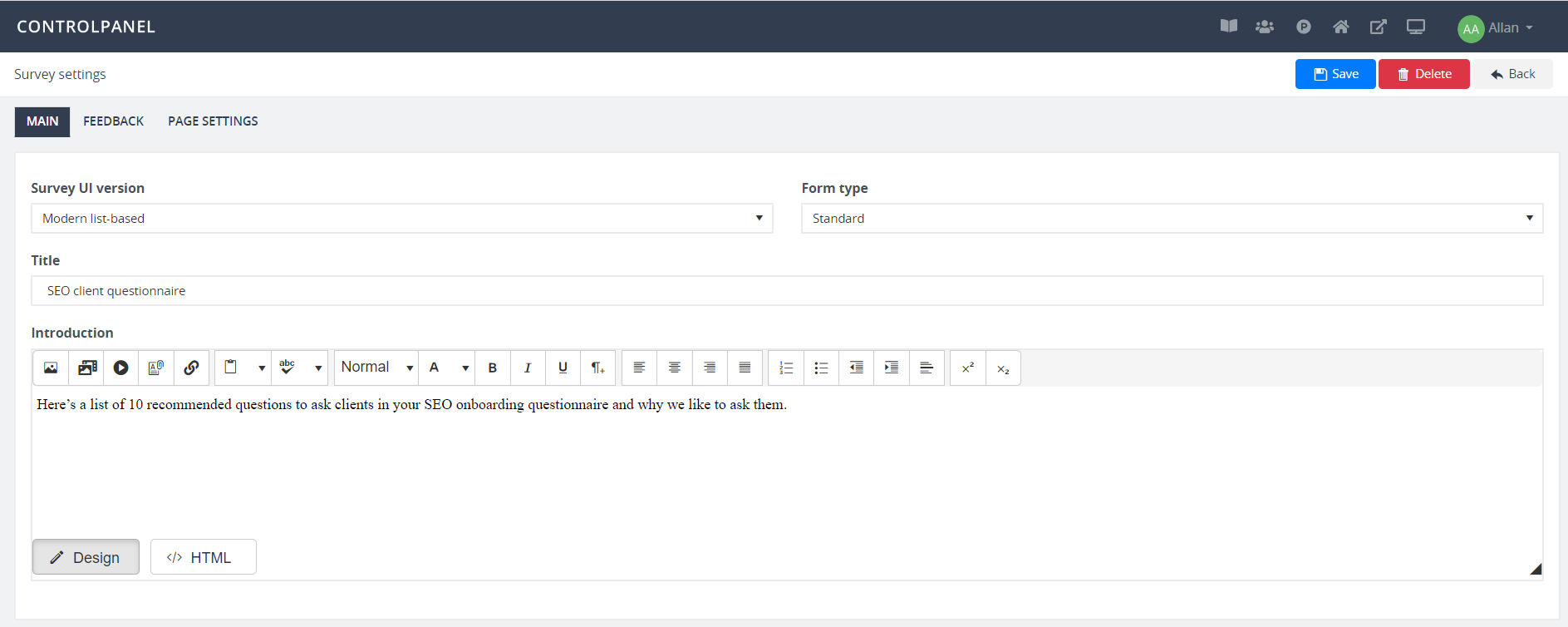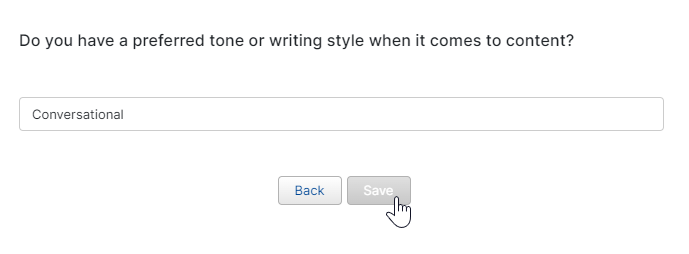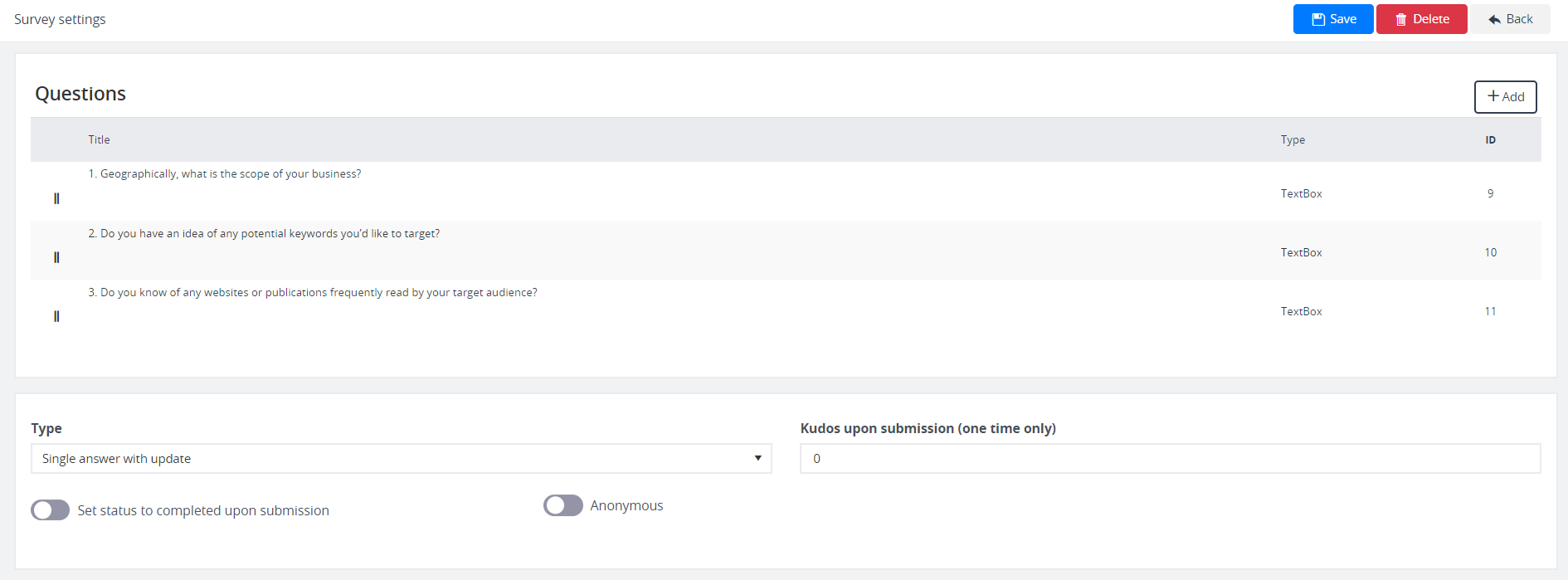Whether collecting data about notable experiences or simply gathering valuable learner feedback, surveys are indispensable tools in online learning.
Not only do surveys help you understand concepts from respondents’ perspectives, but they also allow you to make informed decisions based on such findings.
Using the survey asset in the Control Panel provides you with the same advantages. You can add this asset to ask or require your users to respond to multiple survey questions. And just like any other asset in the Control Panel, the survey asset comes with different customization settings. Let’s discuss these settings one by one.
Survey Settings

Before you create your survey, it’s essential to know how you’d want your users to respond to your questionnaires. Essentially, it begins by determining what survey layout best suits your campaign.
Survey UI Version
Choosing a survey UI version lets you test different survey designs.
Classic table-based – shows a basic two-column table UI template where a selection field or box follows a question.

Modern-based – uses larger text fields for user input. Unlike a table-based design, a modern template is designed like a typical digital survey form, where text fields are placed below the survey questions.

Wizard-based – guides users through a series of steps that must be completed to finish the survey.

Page based on groups – use this type to categorize or group survey questions. This design works like a wizard type where users navigate through a series of grouped pages to complete the survey.
Users Submit History – provides a summary of all submitted survey responses

Feedback on users latest submit on slide – used to provide feedback on a user’s latest survey submission.

Note: Only Classic and Modern UI mode surveys are supported in the Control Panel.
Form type
Different form types are available to serve various survey purposes. Example:
- Standard - choose this type for basic forms of surveys, such as those requiring straightforward responses.
- Requirement form - select this type when users are required to provide their personal information or contact details
- Opinion poll - use this to measure your users’ views regarding a particular topic or series of discussions within a course or session.
- Title – this will serve as your survey’s main header
- Introduction – enter a short text intro to describe what the survey is all about
Questions

You can also drag and drop questions to reorganize their order.

Survey questions come in various types. You create a new survey question by clicking the Add button under Questions. Question types can be:
- Multiple choice – contains multiple answer options.
- TextBox – select this type when collecting short answers from users in text form
- User directory lookup – select this type when responses require searching users from a directory. (Works only in Full Admin)
- Date picker – use this type if responses require entering a specific date.
- Numeric - is similar to a text box but uses numeric values as input.
- TextArea – choose this type if the question requires users to input longer texts.
- Multiple answers – select this type if users must choose more than one of the choices provided.
- Manage directory lookup – select this type when responses require searching managers from a directory. (Works only in Full Admin)
- Group membership selector – use this type when responses require selecting a group (Works in Full Admin)
Read the related article about adding a survey asset to a page.
Selecting an option under the dropdown list Type allows users to give answers they can update.

You can also set the answer type to “no update” when you want users to submit a single answer that they will not be able to update. Below are the different descriptions of each answer type:
- Single answer with update – choose this type to allow users to update their answer
- Single answer with no update – select this type if you want to restrict users from updating their answer
- Multiple answers – use this type to allow users to provide multiple survey responses
- Single answer per Course Session – use this type if a course session with a survey asset requires only a single answer
Enabling the “Set status to completed upon submission” button will trigger the system to change the status to “completed” when a survey is accomplished and submitted. This allows you to use the "Completed or passed" learning objective type on a page/slide.
And turning on the “Anonymous” button enables you to hide a respondent’s name. If you want to create a learning objective on a page with with a survey asset, it may be a good idea to enable the "Set status to completed upon submission" button. This gives users easier means to accomplish course objectives.
Feedback
Go to the Feedback tab to create a message notifying users about their survey completion. You can write a custom feedback message and send an email notification to confirm users’ submissions
Sending an email notification, though, is optional. But if you wish to set this functionality, choose from the following options:
- None - no email or message will be sent to the user
- Send email notifications on submit – an email will be sent to the user upon submitting the survey
- Send email notifications on submit (including survey data) - an email containing survey data will be sent to the user upon completion
In relation to navigation, enable "Use continue button" and "Redirect on feedback window closed" to set specific navigation options. For instance, turning on "Use continue button" provides users the following navigation options:
- Go to next - clicking "Continue" leads users to next page
- Go to user's last bookmark - clicking "Continue" leads users to their last bookmarked page
- Go to CAID - clicking "Continue" takes users to CAID or a selected page
- Go to course start page - clicking "Continue" takes users to the Course's start page
- Go to user's default course - clicking "Continue" leads users to their default course
- Go to previous - clicking "Continue" will take users to the previous page

On the other hand, enabling the "Redirect on feedback window closed" button will automatically take users to the selected destination when the feedback window message is closed.
Note: The page settings page in the Survey asset has the same functionalities as the page settings in the Control Panel.